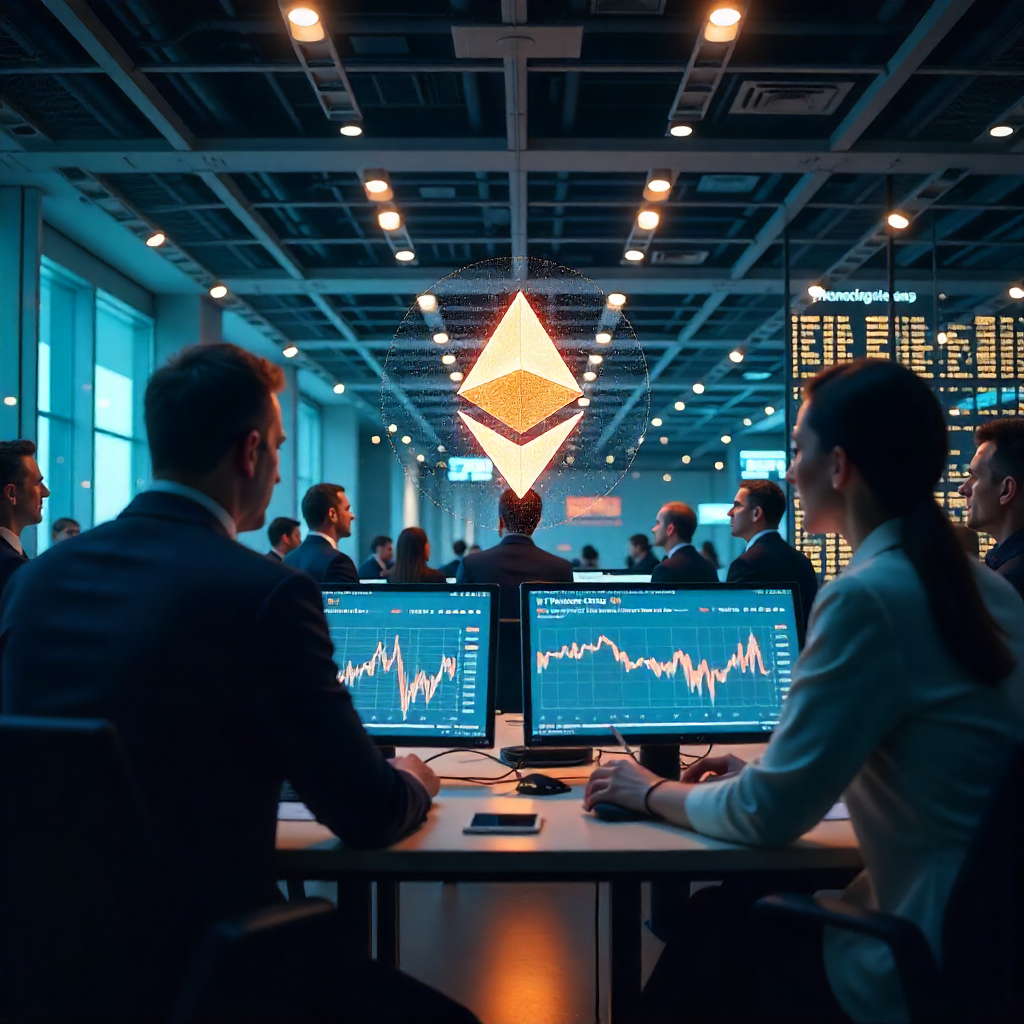A Pivotal Moment for MakerDAO and DAI
DAI, the cornerstone decentralized stablecoin, faces relentless pressure. Maintaining its dollar peg demands constant vigilance. Volatile crypto collateral, Ethereum network congestion, and complex governance create inherent fragility. These challenges threaten DAI’s core promise: unwavering stability. MakerDAO, DAI’s governing body, stands at a crossroads.
Co-founder Rune Christensen has proposed a radical solution. His vision involves building a MakerDAO dedicated blockchain. This purpose-built foundation aims to secure DAI’s future. It signifies a potential tectonic shift for the entire Maker Protocol.
This proposal isn’t incremental change. It’s foundational. A MakerDAO dedicated blockchain represents a complete infrastructure overhaul. Moving core operations off Ethereum carries immense implications. MKR token holders face a defining governance decision.
Understanding this MakerDAO dedicated blockchain proposal is crucial. Its success or failure will profoundly impact DAI’s stability and MakerDAO’s trajectory. This article unpacks Christensen’s vision. We explore its technical basis, potential benefits, significant risks, and the governance path ahead. The future of decentralized finance’s most critical stablecoin may hinge on this very choice. The journey towards a potential MakerDAO dedicated blockchain begins now.
Decoding the Proposal: What is the MakerDAO Dedicated Blockchain?
Rune Christensen’s core proposal is audacious: Build a sovereign foundation. This means creating a MakerDAO dedicated blockchain, often termed “NewChain.” It wouldn’t be just another appchain. It would be a purpose-built Layer 1 blockchain. Its sole focus? Hosting and optimizing the Maker Protocol for maximum DAI stability.
Inspiration & Tech Stack: Why Solana?
Christensen didn’t propose building from scratch. He advocated forking Solana’s codebase. His reasoning, detailed in forum posts, hinges on specific strengths:
Raw Throughput & Low Latency: Solana handles thousands of transactions per second. This speed is critical for fast oracle updates and liquidations.
Proven Scalability: Solana demonstrates handling significant load. This provides a tested foundation for Maker’s growth.
Efficient State Management: Solana’s Sealevel Virtual Machine (SVM) efficiently processes concurrent transactions. This optimizes resource use.
Cost-Effectiveness: Operating its own chain avoids Ethereum’s volatile base layer fees. Predictable, low costs for core operations become possible.
The choice prioritizes performance and cost control. It leverages existing, battle-tested technology. The goal is a stable, efficient base layer.
The “NewChain” Architecture: A Phased Approach
The MakerDAO dedicated blockchain isn’t envisioned as a monolith. Christensen proposes a structured, two-layer system:
Layer 1: NewChain – The Secure Settlement Core
Function: Acts as the bedrock settlement layer. It prioritizes security and finality above all else.
Hosts: Core governance smart contracts, the new GOV token, the MKR token, critical oracle networks, and potentially vaults holding the most secure collateral types (like direct tokenized Treasury bills).
Focus: Ensuring the absolute integrity of governance and key financial operations. Speed here is vital for stability mechanisms.
Layer 2: SubDAOs – Specialized & Scalable
Function: Operate on top of NewChain. They handle specific product lines and riskier operations.
Hosts: Vaults for volatile crypto collateral, user front-ends, specific services, and experimental features. Each SubDAO issues its own token (SPRK).
Focus: Scalability, user experience, and managing diverse collateral pools. They leverage NewChain’s security while enabling innovation.
This separation creates specialization. NewChain provides rock-solid security for the essentials. SubDAOs offer flexibility and scale for user interactions and riskier assets.
Key Motivations: Why Build a Dedicated Chain?
Christensen argues the current Ethereum-centric model imposes critical limitations. The MakerDAO dedicated blockchain directly targets these pain points:
Eliminate Ethereum Dependence: Reduce vulnerability to Ethereum gas spikes, network congestion, and unexpected consensus changes. Achieve true operational sovereignty.
Optimize Protocol Performance: Tailor everything – consensus, VM, fee structure – specifically for Maker’s needs. Enable near-instant oracle updates and liquidations crucial for DAI peg stability.
Enhance Security Sovereignty: Gain full control over the base layer’s security model and upgrade process. Mitigate risks from external chain failures or governance.
Enable Governance Scalability: Execute complex governance actions and manage SubDAOs efficiently. Remove Ethereum’s speed and cost as bottlenecks for critical decisions.
Secure Long-Term Cost Efficiency: Avoid the projected long-term trajectory of Ethereum L1 costs for core protocol functions. Ensure sustainable operations.
The MakerDAO dedicated blockchain is framed as essential infrastructure. It aims to provide the stable, efficient, sovereign foundation DAI requires to thrive long-term. This move is central to realizing the ambitious Endgame vision.
The Endgame Vision: Where Does the Dedicated Blockchain Fit?
Rune Christensen’s MakerDAO dedicated blockchain proposal isn’t isolated. It’s the central engine powering MakerDAO’s ambitious “Endgame” vision. Endgame aims for resilience, efficiency, participation, and scalability. The MakerDAO dedicated blockchain, dubbed NewChain, provides the essential infrastructure to achieve this.
NewChain: The Foundational Bedrock
Endgame requires a robust, purpose-built foundation. Ethereum, while secure, presents limitations for Maker’s specific needs. Gas costs, network congestion, and governance speed bottlenecks hinder progress. NewChain solves this. It becomes the optimized settlement layer. Everything critical anchors here.
This MakerDAO dedicated blockchain offers sovereign control. MakerDAO dictates its consensus rules, upgrade paths, and fee structures. This autonomy is vital for tailoring the environment precisely to DAI stability mechanisms and complex governance.
Enabling the SubDAO Ecosystem
Endgame envisions specialized units called SubDAOs. These handle specific product lines and collateral types. Think of them as focused subsidiaries. However, SubDAOs cannot operate in a vacuum. They need a secure, high-performance base layer.
Security Inheritance: SubDAOs built on top of NewChain inherit its base layer security. They settle critical transactions on NewChain. This provides a strong security guarantee without each SubDAO managing its own validator set.
Efficient Communication: NewChain facilitates seamless, low-latency communication between SubDAOs and the core protocol. Fast data exchange is crucial for risk management and unified operations.
Shared Infrastructure: Critical services like core oracles and security modules reside on NewChain. SubDAOs access them reliably and efficiently. This avoids duplication and fragmentation.
Without the MakerDAO dedicated blockchain, the SubDAO model becomes far riskier and less efficient. NewChain provides the necessary cohesion and security foundation.
Powering the “Alignment Artifacts”
Endgame introduces new token dynamics – the “Alignment Artifacts.” This system involves MKR, a new GOV token (for core governance), and SubDAO tokens (SPRKs). Their interaction drives participation and aligns incentives.
MKR & GOV: MKR holders lock tokens to receive GOV tokens. GOV powers core governance votes on NewChain. The dedicated chain ensures these critical votes execute swiftly and cheaply.
SPRK Generation: SubDAOs issue SPRK tokens to participants. These tokens derive value partly from their connection to the secure NewChain infrastructure.
Unified Settlement: The flow of value and governance signals between MKR, GOV, and SPRKs relies on NewChain. It acts as the secure settlement layer for this entire token economy.
The MakerDAO dedicated blockchain is the indispensable platform enabling Endgame’s complex tokenomics and governance flow. It binds the vision’s components into a functional whole. NewChain isn’t just part of Endgame; it’s the foundational infrastructure making Endgame technically feasible and secure. The success of this grand vision hinges on the successful implementation of this dedicated base layer.
Potential Benefits of a MakerDAO Dedicated Blockchain
Rune Christensen’s MakerDAO dedicated blockchain proposal promises transformative advantages. Its core aim is fortifying DAI stability while enabling unprecedented protocol efficiency and control. Let’s examine the key potential benefits driving this ambitious vision.
Unmatched Stability Mechanisms
Faster Oracle Updates & Liquidations: Current Ethereum delays (often 12+ seconds per block) create vulnerability windows. NewChain’s sub-second block times enable near real-time price feeds. Liquidations trigger almost instantly during volatility. This dramatically reduces undercollateralization risk.
Predictable Low-Cost Operations: Eliminating Ethereum gas auctions ensures stable, minimal fees for critical functions. Oracle updates and liquidations won’t get priced out during network congestion. Stability mechanisms become reliably affordable.
Protocol Sovereignty & Control
Tailored Infrastructure: Every layer – consensus, VM, fee market – optimizes for Maker’s needs. No compromises for general-purpose chain requirements. Security parameters directly serve DAI stability.
Eliminated Third-Party Risk: Mitigates reliance on Ethereum’s roadmap, governance, or potential failures. MakerDAO controls its own destiny and upgrade paths for the MakerDAO dedicated blockchain foundation.
Enhanced Security Customization: Ability to implement specialized security features (e.g., advanced fraud proofs, MEV resistance) specific to DeFi and stablecoin operations.
Radical Efficiency & Scalability Gains
Near-Instant Settlement: Core governance actions, collateral management, and DAI minting/redeeming settle in seconds. Drastically improves user and SubDAO experience.
Governance Unshackled: Complex governance processes execute swiftly and cheaply on NewChain. Managing SubDAOs, adjusting risk parameters, or upgrading the protocol avoids Ethereum bottlenecks.
Foundation for Growth: High throughput accommodates massive scaling of vaults, SubDAOs, and users without degrading performance or inflating costs for core functions.
Sustainable Economics & Value Capture
Long-Term Cost Reduction: Avoids perpetually rising Ethereum L1 costs for billions in protocol operations. Predictable low fees enhance the protocol’s economic sustainability.
Optimized Fee Structures: Potential for novel fee models (e.g., stability fees settled directly on-chain efficiently) benefiting the protocol treasury and tokenomics.
Value Accrual Within Ecosystem: Fees generated by core NewChain operations (e.g., settlement, governance) potentially benefit MKR/GOV holders and the protocol directly, strengthening the ecosystem.
Enabling Future Innovation
Native Feature Integration: A purpose-built chain simplifies adding sophisticated native capabilities. Examples include advanced privacy for vaults, specialized collateral modules, or integrated bridging protocols.
SubDAO Experimentation: Provides a secure, high-performance base layer empowering SubDAOs to innovate rapidly with diverse collateral and products, knowing core stability is robustly handled.
The MakerDAO dedicated blockchain offers a compelling path toward an ultra-resilient DAI. It targets the core operational friction points head-on, promising a level of speed, control, and cost efficiency unattainable on shared general-purpose networks. This potential infrastructure leap is central to MakerDAO’s Endgame ambition of becoming the unshakeable backbone of decentralized finance.
Significant Challenges, Risks, and Criticisms
While the MakerDAO dedicated blockchain (NewChain) vision offers compelling benefits, its path is fraught with substantial hurdles. MKR governance must critically evaluate these risks before committing to such a foundational shift.
Daunting Technical Complexity & Execution Risk
Building a Secure L1 is Hard: Launching a robust, battle-tested Layer 1 blockchain is an enormous engineering feat. Solana itself faced significant outages early on. Replicating and adapting this complexity carries inherent risk.
Audit Burden: Securing NewChain demands exhaustive, continuous audits. Vulnerabilities in the base layer could jeopardize the entire Maker Protocol and billions in locked value.
Validator Set Challenges: Bootstrapping and maintaining a sufficiently decentralized, high-performance validator set for the MakerDAO dedicated blockchain is non-trivial. Centralization risks exist.
The Perilous Migration Process
Multi-Step, Multi-Asset Migration: Moving core protocol elements (MKR/GOV tokens, governance contracts, critical vaults, oracles) from Ethereum to NewChain is incredibly complex.
Bug Risk: Any flaw in migration smart contracts or processes could lead to fund loss or protocol paralysis. Testing must be exhaustive.
User/Integrator Confusion: Migrating users, vault owners, and third-party integrators (wallets, exchanges, DeFi protocols) requires immense coordination and clear communication. Missteps cause fragmentation or loss of trust.
Temporary Instability: The transition period itself could create windows of vulnerability for DAI stability and protocol security.
Centralization Concerns and Sovereignty Trade-offs
Validator Centralization Fears: Critics worry initial validators might be overly centralized, contradicting DeFi principles. Long-term decentralization isn’t guaranteed.
Governance Control Concentration: Controlling the base layer raises questions. Does this concentrate too much power within Maker governance compared to leveraging Ethereum’s neutral base?
“Not Ethereum Security”: Abandoning Ethereum’s vast, battle-tested security pool for a new chain is a fundamental trade-off. NewChain’s security must prove itself over time.
Community and Adoption Risks
Governance Fatigue & Apathy: The sheer complexity might overwhelm MKR holders, leading to lower participation in critical votes.
Potential for Forking/Exit: Significant community disagreement could trigger forks, splitting protocol value and community focus. Key stakeholders might leave.
SubDAO & Builder Adoption: Will SubDAOs and developers enthusiastically build on NewChain? Liquidity and user experience must be superior to attract them.
Liquidity and Economic Hurdles
Bootstrapping Liquidity: Ensuring deep, stable liquidity for MKR, GOV, DAI, and collateral assets on NewChain is crucial and challenging. Thin liquidity harms stability.
Bridging Reliance: Initially, significant value movement relies on bridges between Ethereum and NewChain. Bridges remain a major security vulnerability in crypto.
Cost Justification Scrutiny: The immense R&D, development, and ongoing operational costs of the MakerDAO dedicated blockchain face scrutiny. Could robust Ethereum L2 solutions achieve similar benefits faster and cheaper?
Alternative Perspectives
“Optimize Ethereum L2s Instead”: Many argue MakerDAO should deeply integrate with leading Ethereum L2s (e.g., using OP Stack, Arbitrum Orbit, zkSync Hyperchains). This leverages Ethereum security while gaining scalability and lower costs.
“Choose Established Appchain Tech”: Questions persist on forking Solana vs. using established appchain frameworks like Cosmos SDK or Polkadot SDK, which offer proven interoperability and validator tools.
“Premature Optimization?”: Is the complexity justified now, or could phased improvements on Ethereum suffice until the need is clearer?
The MakerDAO dedicated blockchain proposal is a high-risk, high-reward gamble. Its success hinges on flawless execution across technical, migration, security, and community dimensions. MKR holders must weigh these formidable challenges against the promised benefits with extreme diligence. The stability of DAI itself is the ultimate stake.
The Path Forward: Governance Process and Next Steps
Rune Christensen’s MakerDAO dedicated blockchain (NewChain) proposal remains exactly that: a proposal. Its fate rests entirely with MKR token holders through MakerDAO’s decentralized governance. Understanding the pathway is crucial for informed participation.
Current Status: Deep Discussion Phase
Forum Debate Intensifies: The proposal is undergoing rigorous scrutiny on the MakerDAO Governance Forum. Developers, delegates, risk teams, and MKR holders are dissecting technical feasibility, migration plans, costs, and alternatives.
No Formal Votes Yet: No on-chain governance votes have occurred. This is still the research and community signaling stage. Major decisions require formal MIPs (Maker Improvement Proposals).
The Staged Governance Journey
Approving a change of this magnitude demands a structured, multi-phase process. Expect these key stages:
Signal Requests & Temperature Checks:
Non-binding polls gauge initial community sentiment.
Questions might focus on core principles: “Should MakerDAO prioritize building a dedicated blockchain?” or “Is forking Solana the preferred approach?”
Results inform whether to proceed to formal specification.
Architectural Specification (MIPs):
Core engineering units and community contributors draft detailed Maker Improvement Proposals.
These MIPs define the MakerDAO dedicated blockchain architecture, tokenomics (MKR/GOV/SPRK flow), migration mechanics, validator selection, security audits, and budget requirements.
Extensive peer review and revision occur before formal submission.
On-Chain Governance Votes – Approval & Funding:
MIP Approval Votes: MKR holders vote to accept or reject the formal specifications outlined in the MIPs. This is the primary approval gate.
Funding Votes: Separate votes allocate necessary funds from the Maker Protocol treasury for research, development, testnet deployment, security audits, and migration tooling. Large budgets will face intense scrutiny.
Core Implementation & Migration Votes:
Testnet Launch Approval: Vote to deploy initial testnet versions of NewChain.
Security Milestones: Votes may be required after critical audits or security reviews before progressing.
Migration Activation: Ultimate votes authorize the start of the phased migration process for governance contracts, tokens, oracles, and eventually vaults. This is the point of no return.
Timeline Expectations: A Long Haul
Years, Not Months: Building, securing, testing, and migrating to a new L1 blockchain is a multi-year endeavor. Christensen’s initial Endgame phases suggested a 3+ year horizon.
High Uncertainty: Timelines depend entirely on governance approval speed, technical hurdles encountered, and audit findings. Delays are highly probable.
Phased Rollout: Migration won’t happen overnight. Expect gradual steps: governance migration first, followed by oracles, then selected vault types (e.g., RWA first), and finally broader vaults/SubDAOs.
The Imperative Role of MKR Holders
Ultimate Decision-Makers: MKR holders possess the sole power to approve or reject this transformation via on-chain voting. Delegates execute votes based on voter mandates.
Demanding Diligence: This decision requires deep technical and economic understanding. Relying solely on delegate summaries is risky. Engage with forum discussions, read MIPs, and scrutinize cost/benefit analyses.
Active Participation is Non-Negotiable: Low voter turnout on such a foundational issue could delegitimize the outcome or lead to capture by highly motivated minorities. Voting is a core responsibility.
The journey toward a potential MakerDAO dedicated blockchain is just beginning. MKR holders must now navigate a complex governance gauntlet, demanding unprecedented levels of scrutiny and participation. The stability of DAI and the future of the Maker Protocol hang in the balance.
A Defining Crossroads for Maker Governance
Rune Christensen’s proposal for a MakerDAO dedicated blockchain (NewChain) marks a pivotal juncture. It’s not merely an upgrade—it’s a fundamental reinvention of MakerDAO’s infrastructure to anchor DAI stability for decades. The ambition is clear: a sovereign, high-performance foundation purpose-built for the Endgame vision.
The Core Trade-Off
Promise: Unprecedented speed for liquidations/oracles, governance agility, cost control, and sovereignty.
Peril: Execution complexity, migration risks, validator centralization questions, and abandoning Ethereum’s battle-tested security.
This isn’t a technical tweak. It’s a high-stakes bet on self-reliance versus the security of the established ecosystem.
The Governance Imperative
MKR holders now face their most consequential vote since MakerDAO’s inception:
Due Diligence is Non-Negotiable: Scrutinize forum debates, audit plans, and migration roadmaps.
Reject Passivity: Low turnout risks delegating this decision to vocal minorities. Vote.
Prepare for Multi-Year Execution: Approval triggers a complex, phased rollout demanding sustained governance engagement.
The Stakes
DAI’s $5B+ stability backbone hinges on this choice. Failure could fragment the community or destabilize the peg. Success would position MakerDAO as a self-sovereign DeFi powerhouse.
Final Word
The MakerDAO dedicated blockchain proposal is a bold answer to existential challenges. It embodies crypto’s ethos of self-determination—but tests the limits of decentralized execution. As MKR holders weigh risks against rewards, one truth remains: Inaction is the riskiest path of all. The future of decentralized stablecoins will be shaped here.





